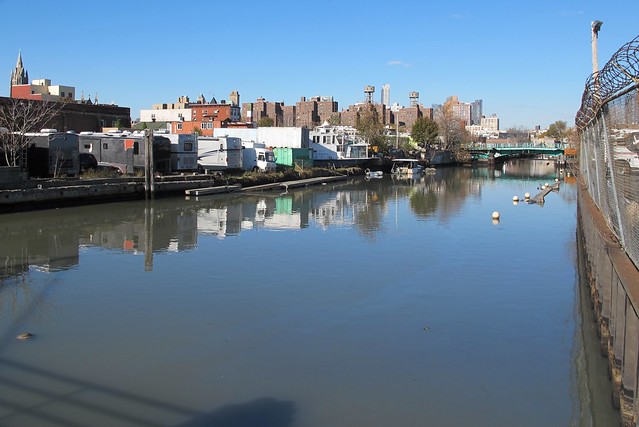Riverkeeper, New York's clean water advocacy group, has been doing a tremendous job of informing the public of the water quality around New York City Harbor in the days after Hurricane Sandy.
On November 2nd, four days after the storm, Riverkeeper conducted it's first patrol to take water samples. The group followed up with additional tests on November 8th.
(To see the results of all testing, click here)
Surprisingly, the result of the tests showed better than average water quality at all testing sites, except for the Gowanus Canal, which indicated extremely high levels of sewage contamination.
The Gowanus samples from November 2nd, which were taken at the Hamilton Avenue Bridge indicated an unacceptable Enterococcus counts of >24,196 per 100ml. (The US Environmental Protection Agency guideline threshold for primary contact is 104 Entero per 100ml.)
On November 8th, one day after the Nor'Easter, the samples taken at the same location again showed Enterococcus count of >24,196 per 100 ml.
See photos taken by Riverkeeper on November 8th at Gowanus CSO outflow.
On November 9th, Riverkeeper checked the same location on the Gowanus again and still observed dry weather flow. See photos below.
On November 2nd, four days after the storm, Riverkeeper conducted it's first patrol to take water samples. The group followed up with additional tests on November 8th.
(To see the results of all testing, click here)
Surprisingly, the result of the tests showed better than average water quality at all testing sites, except for the Gowanus Canal, which indicated extremely high levels of sewage contamination.
The Gowanus samples from November 2nd, which were taken at the Hamilton Avenue Bridge indicated an unacceptable Enterococcus counts of >24,196 per 100ml. (The US Environmental Protection Agency guideline threshold for primary contact is 104 Entero per 100ml.)
On November 8th, one day after the Nor'Easter, the samples taken at the same location again showed Enterococcus count of >24,196 per 100 ml.
See photos taken by Riverkeeper on November 8th at Gowanus CSO outflow.
On November 9th, Riverkeeper checked the same location on the Gowanus again and still observed dry weather flow. See photos below.
As we all know, New York City still discharges Combined Sewer Overflow (CSO) into the Gowanus during heavy downpours. However, Hurricane Sandy, though destructive, was not a significant rain event. Riverkeeper concludes that "the extreme contamination in the Gowanus Canal is probably due to additional, perhaps ongoing, sewage discharges from CSOs or bypasses into the Canal continuing after the tidal flooding ended."
Below is a more detailed summery on the findings by John Lipscomb and Andy Juhl of Riverkeeper:
We have been sampling to quantify the frequency and severity of sewage contamination around Manhattan and in the Hudson River for over 5 years, so we have a fairly good idea what typical conditions are like, and water quality around NYC is probably better most of the time than most people think. There are intermittent problems, mostly following rain, but also because of occasional infrastructure failures (i.e., broken pipes or pumps). Still, during dry weather, more than 90% of the samples we have collected around NYC are “acceptable” from the perspective of microbial indicators of sewage.
That’s the good news, the bad news is that we do see widespread sewage contamination following rain, which is not an uncommon event.
We have heard a lot of concerns about water quality following Hurricane Sandy. Not only do we generally see the frequency and levels of contamination in the Hudson rise following rain, but because of the flooding, there were a large number of people who would have been exposed to the water, if it was contaminated. So there was justifiable reason for concern.
Unfortunately, we don’t have any data from during or immediately after the storm. Given the amount of rain (approximately 1 inch overnight), it is possible that there would have been sewage discharges from CSO’s. It is also possible that the enormous volume of water associated with the high tide and storm surge would have diluted any sewage inputs. Without data we cannot say which of these is most likely.
Given what we know about sewage contamination following storms, we expected that if there were high levels of sewage contamination during the storm, it would be relatively short-lived. The system tends to clean itself out after a sewage input event after 3-4 days although it is variable depending on location and conditions. The exception would be if there was continuing discharge, for example from pipes or pumps that were damaged by the hurricane, or if there was additional precipitation.
One can speculate and extrapolate all you want, but there really is no way to answer any of the questions about water quality without going out and sampling. You need good data, so we went out and collected some. On Friday Nov 2, 4 days following the storm, John Lipscomb from Riverkeeper was able to collect a few samples from near Manhattan, and I was able to collect a few samples on Nov 6 (once our power came back) from the shore in Rockland Co, north of NYC. Taken together, those samples show acceptable water quality at 7 of 10 locations. The three locations with unacceptably high counts of Enterococcus were Sparkill Creek, Newtown Creek, and Gowanus Canal, all places where we see very frequent contamination problems. So taken together, these limited data suggest that if there was widespread sewage contamination following the hurricane, conditions were reverting back to normal. Unfortunately, for some locations, normal conditions are contaminated.
Looking at the data in more detail, there is another story that can be identified. The Gowanus sample several days after the hurricane was remarkably high. With an Entero count of >24200, the water in Gowanus was more than 230 times the threshold where you would close a water body for swimming. We suspect that this sample indicates that there was a continuing release of sewage into the Gowanus canal. This is the level of contamination we see during a rainstorm while CSO’s are flowing, or if there was a broken pipe, pump station, or some other infrastructure problem that caused ongoing release of raw sewage. It is possible that this extremely high level of contamination was related to hurricane damage to sewage treatment infrastructure that has not yet been repaired.
So we had some evidence for infrastructure problems that might be Hurricane-related, but we had no idea whether that was widespread. We may have caught one instance (in Gowanus), but there could be more, so in the face of continuing concern from the public and the media, we decided to do some more comprehensive sampling on Nov 8th. So that’s more than a week after the Hurricane. Just to make things complicated, the night before our Nov 8 sampling trip, the area was hit by another strong storm, that dumped anywhere from 1 to 6 inches of snow and rain on the ground. We predicted that this winter storm would lead to fairly widespread sewage contamination, as happens just about every time we get precipitation.
In fact, we did see evidence for widespread sewage contamination on Nov 8., more than 2/3 of the samples we collected had unacceptably high counts of sewage indicating microbes. Because some of those stations were OK a few days earlier, we think that these results are dominated by the impacts of the overnight snow/rain storm. We hope that this highlights the fact that we have a pretty common sewage contamination problem. It’s not necessarily because of big events like Sandy, it happens all the time. Because this type of sewage contamination is common, it really should be more of a concern than the concern we are seeing now about sewage contamination following a big, rare event, like a direct hit from a hurricane.
Drilling down into the most recent numbers in more detail, we did see very high counts of sewage indicators coming from 2 of the 3 sewage treatment plant outfalls we sampled. We also again found exceeding high counts in Gowanus canal. Those cases do suggest to us that there may be some ongoing infrastructure problems. They are localized, but they need to be fixed. Those kind of infrastructure breakdowns are the kinds of things we would expect to see following a big event, like Hurricane Sandy. However, we cannot definitely connect these specific cases to the Hurricane.




















